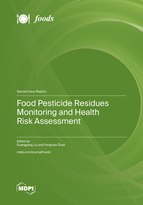Food Pesticide Residues Monitoring and Health Risk Assessment
A special issue of Foods (ISSN 2304-8158). This special issue belongs to the section "Food Quality and Safety".
Deadline for manuscript submissions: closed (20 November 2023) | Viewed by 40025
Special Issue Editors
Interests: using functional nanohybrid materials to monitor the quality and safety of agricultural products; nanoscale identification and sensing of agricultural chemical pollutants and nutrients; mechanism of nano-controlled removal and catalytic degradation of agricultural chemical pollutants; research and development of nano pesticide and nano fertilizer; sample pretreatment; pesticide residue monitoring; dietary risk assessment; development of new pesticide detection technologies
Special Issues, Collections and Topics in MDPI journals
Interests: functional nanomaterial-enabled smart devices and their application in the rapid analysis for quality and safety of agricultural products
Special Issue Information
Dear Colleagues,
Pesticides are widely used in agriculture, playing an important role in the prevention and control of diseases and insect pests, such as cordyceps. Hence, pesticide residue and food safety problems have become concerns that need to be addressed. With the increasing awareness of health care and food safety, advanced technologies and reasonable treatments to mitigate pesticide residue are essential. These demands have led food-safety-focused researchers to develop advanced analytical technologies for accurate assessment of pesticide residue and demonstrate the relationship between pesticide residue in food and human dietary health, showing the importance of ensuring food safety and a healthy diet.
With this Special Issue, we hope to present recent developments in using novel technologies/nanomaterials to monitor/remove pesticide residues in food, exploring the molecular mechanism of pesticide removal in food and the relationship between pesticide residues and food safety/dietary health to promote food pesticide residue monitoring and health risk assessment. Original research articles, reviews, and short communications will all be accepted.
Dr. Guangyang Liu
Dr. Fengnian Zhao
Guest Editors
Manuscript Submission Information
Manuscripts should be submitted online at www.mdpi.com by registering and logging in to this website. Once you are registered, click here to go to the submission form. Manuscripts can be submitted until the deadline. All submissions that pass pre-check are peer-reviewed. Accepted papers will be published continuously in the journal (as soon as accepted) and will be listed together on the special issue website. Research articles, review articles as well as short communications are invited. For planned papers, a title and short abstract (about 100 words) can be sent to the Editorial Office for announcement on this website.
Submitted manuscripts should not have been published previously, nor be under consideration for publication elsewhere (except conference proceedings papers). All manuscripts are thoroughly refereed through a single-blind peer-review process. A guide for authors and other relevant information for submission of manuscripts is available on the Instructions for Authors page. Foods is an international peer-reviewed open access semimonthly journal published by MDPI.
Please visit the Instructions for Authors page before submitting a manuscript. The Article Processing Charge (APC) for publication in this open access journal is 2900 CHF (Swiss Francs). Submitted papers should be well formatted and use good English. Authors may use MDPI's English editing service prior to publication or during author revisions.
Keywords
- nanomaterial-based pretreatment
- pesticide residue monitoring
- novel analytical technology
- pesticide-sensing device
- pesticide separation mechanism
- food safety
- analytical methods
- evaluation model
- dietary risk assessment
- health risk assessment
Benefits of Publishing in a Special Issue
- Ease of navigation: Grouping papers by topic helps scholars navigate broad scope journals more efficiently.
- Greater discoverability: Special Issues support the reach and impact of scientific research. Articles in Special Issues are more discoverable and cited more frequently.
- Expansion of research network: Special Issues facilitate connections among authors, fostering scientific collaborations.
- External promotion: Articles in Special Issues are often promoted through the journal's social media, increasing their visibility.
- Reprint: MDPI Books provides the opportunity to republish successful Special Issues in book format, both online and in print.
Further information on MDPI's Special Issue policies can be found here.








